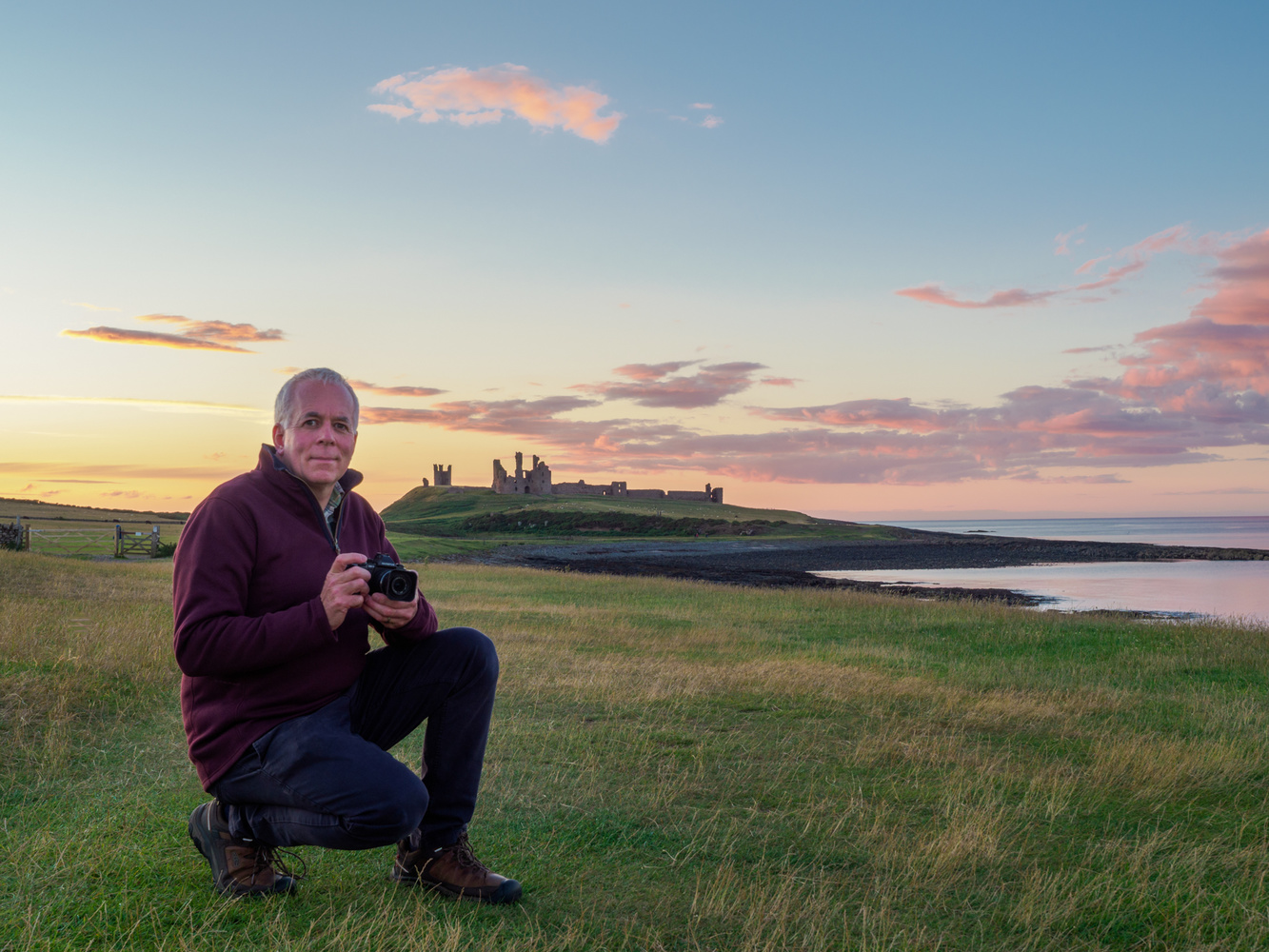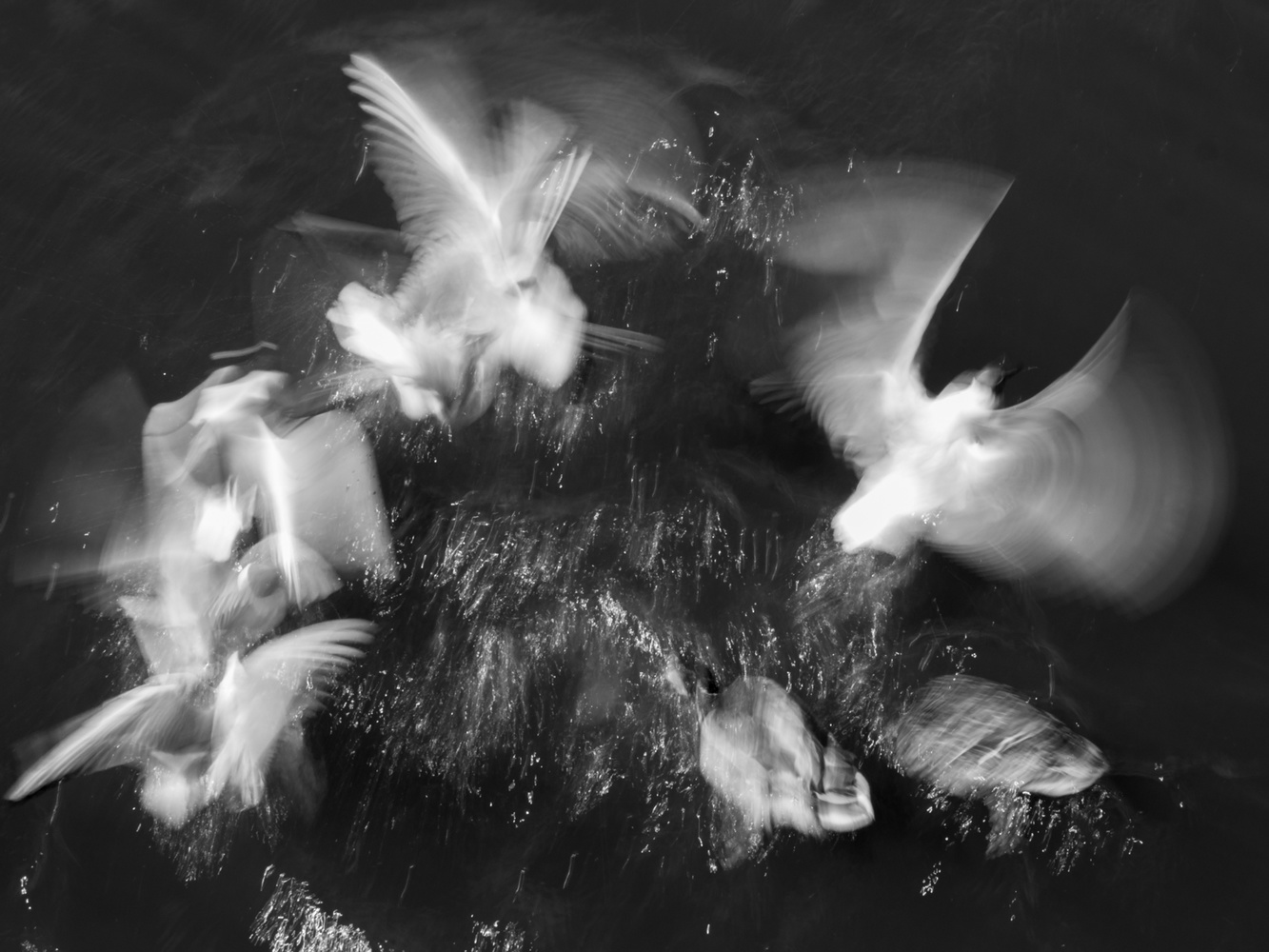Every technical and compositional skill you have in your toolbox cannot give your images meaning. Of all the considerations, putting meaning into an image is probably the hardest to achieve. It’s an esoteric thing, but it can help lift your photographs from the mundane to extraordinary.
Applying Different Levels of Meaning
Learning to read at aged four, I was given a book that started “Peter.” On the opposite page was a picture of Peter. Overleaf, it said, “Jane,” and a picture of her accompanied it. It then went on to introduce a dog. They were very simple statements that described the illustrations.
Similarly, at their basest level, photographs amount to little more than that. I call them “This is” photos: “This is a cat,” “This is me,” and so on. To that, you can add location to make it a bit more meaningful: “This is me at Dunstanburgh Castle,” plus, a time: “This is me, at Dunstanburgh Castle, at sunset.” Every photograph has some level of meaning.

This is me at Dunstanburgh Castle at sunset.
But the meanings of those aren’t very deep. They don’t challenge us in the way some photos do. However, we can create better images that mean so much more than those simple statements.
There are some genres of photography that prove easier to convey a deeper meaning than others. For example, street photography usually has images of interesting-looking people doing interesting things — they tell a story. Whereas, with landscape photography, it’s more challenging to instill deeper meaning beyond showing its beauty: “this is a pretty stream, with pretty mountains in the background.”
So, how do we add greater meaning?
1. See the World With Unique Eyes
The combinations of shutter value, focal length, subject distance, framing, camera height and angle, light direction, light color, and intensity, and processing all allow us to create our own unique ways of portraying a subject. Yet, many photographers choose to stick to the formulaic rules of how the photograph should appear. In fact, we are often judged by subjective prescriptions that do little more than encourage sausage machine photography. They may please a judge’s eye, but they don't push the boundaries of creativity.
There are, of course, times when being formulaic is necessary. When clients commission me to provide images that conform to their brief, then there is usually little space to expand that creatively. That notwithstanding, like all artists, as creative photographers, we are usually trying to show the world in a way that most people don’t see it. Conveying our own unique perspective is an important part of the photograph’s meaning.

The child on the right plays in the sea with the younger ones, the long exposure shows their movement. Meanwhile, the older teenager, dressed entirely in black, watches on but doesn't join in. The darkening of the clothing also reflects both their relative ages and resilience to the sea.
2. Meaningful Images Are not Necessarily Popular
The sad truth is that many of our images’ viewers have unsophisticated tastes; just look at the most popular TV shows to know this is true. Consequently, if you make a living from selling photographs or scoring lots of Instagram likes is important to you, then you are probably going to choose to shoot crowd-pleasing and unchallenging snaps of bouncing lambs, scantily clad young women, birds on sticks, mountain streams, and sunsets.
Don’t get me wrong, I am not knocking any of those photographs. Just as X Factor has its place in popular culture, so do those images. However, if you want to take your photos to another level, adding deeper meaning to them, that takes thought and an acceptance that you might be shunning popular appeal.
So, experiment with pushing boundaries and don't worry about popularity.
3. Accept Your Meaning Isn't the Same as Mine
Adding your meaning to an image doesn’t necessarily mean the viewer can read it. Their personal window onto the world is likely very different from yours. Their political beliefs, religion, philosophy, state of mind, experiences, location, and personal circumstances will all result in their interpretation of your photo being different from yours, and that’s okay. If you want the reader to be assured of the meaning you are trying to convey, then consider directing them by adding a caption or title.

A title or caption can direct the way an image is understood. This image could be entitled "Peace," or "Lonely," or "Freedom," or "Walking Home," or "I Miss You," and each would give a different meaning to the image.
4. Photograph Your Passion
Meaning is so much more than what is recorded on the frame. If there is something that you have strong feelings about, then make that your subject, and that fire will come through in your photography.
It doesn’t matter whether it is anger at a social or environmental issue, your joy at seeing the sunrise, or finding subjects that challenge your beliefs, being truly enthusiastic and emotionally invested in your subject will be evident in your images. Why? If you care about it, you will notice the small things that give the photo meaning and go that extra mile to get the image.
Equally, if you don’t care about what you are shooting, then you will know that, and your viewers won’t care either.
5. Be Respectful of Your Subject
If you are impassioned by your subject, then respect it.
One of the branches of photography I teach is birds in flight. As bait, I bake a special cake with no salt, sugar, raising agents, or bleached flour. Instead, there are lots of fats, seeds, fruit, and mealworms. I believe that if I am enticing birds for me to photograph, then I should give something valuable back to them. What I don’t do is attract birds by playing the territorial call of the same species. That is common practice, but it is distracting the bird from all the things it does to survive and raise its young.

Birds in flight.
Sometimes, we cannot give back immediately. Heading out into the fragile wilderness requires us to cause as little interference as possible, but it isn’t immediately obvious what we can give in return. However, we can use our photography to raise awareness of the environment and encourage respect from others.
An area where many get it wrong is photographing the homeless. If you take a photograph of a person down on their luck, then you are benefiting from their misfortune. You need to give something back, something worth a lot more than the few notes you leave in their collection pot. Kindness and understanding is a good place to start.
These considerations will become apparent in your photography. Why? Firstly, your caring reputation will rub off onto your photos and how people read meaning into them. Conversely, if people consider you to be uncaring or mean, then they will have a cynical view of your photography. Secondly, as with my point number four, your care for the subject will be evident and shine through in your images.
6. Repeatedly Photograph the Same Subject
Whether it is a person, animal, or inanimate object, everything has qualities and traits that I call personality. The more you photograph something, the more familiar you will become with it. Familiarity with a subject will improve your ability to add meaning to your photographs. The better you know it, the more likely you are to find a way to shoot it that best reveals its personality. So, repeatedly revisiting the same subject not only helps you to hone your skills, but also discover new ways of portraying its story.
However, don’t get stuck by limiting yourself too much. Digressing from a theme or even a genre can help us grow as photographers, and that in itself can change what people read into our images.
7. ...But Avoid Clichés
Overuse of subjects and techniques in photography is problematic for photographers. In writing, it is an easy thing to avoid. But, just as composers are running out of combinations of notes, photographers can struggle to put across deeper meanings when a subject or technique gets overworked. Selective coloring is an obvious example. Or, take the ubiquitous selfie. How many have you seen? Lots. How many of those do you clearly remember? One or two, maybe. They are lost in a fog of unchallenging sameness.

A gull in the fog, avoiding a cliché in wildlife photography.
Similarly, wedding photographs can be boring. Great wedding photographers put their own stamp on the event that makes their photography stand apart from the crowd. Sadly, however, many produce photos that don’t look that different from the next wedding a quarter of a mile down the road.
The wedding photographs’ story can and should be much more than a record of the event. This isn’t a criticism of wedding photography, the same failure can be aimed at any branch of our art.
Seek subjects and ways of photographing them that are unique to you. Make it your style. That aesthetic will give continuity across all your photos and add overall meaning to your photos. But, when you tire of that style, change.
Thanks for taking the time to read this. Is putting meaning into your photos is important to you? How do you go about it? It would be great to see some of your images in the comments so other readers can discern meaning from them.







I like the word “meaningful” rather than “meaning”. Meaning implies symbolism, metaphor or narrative which could be literal or implied. Meaningful means affecting the mind, heart or spirit.
Sublime or challenging aesthetics can make any of the arts meaningful. The visual arts, including photography, can function in similar ways to music, which does not require lyrics to be meaningful. Photography can even even be overtly abstract.
Developing an eye for unexpected juxtapositions or visual syntax, looking for the subtle nuances in forms or the play of light are examples of strategies for development as a photographer.
Good points, Doug. Thanks for the insightful comment, that's really useful.
Your articles are top. Thank you very much. As another item one could add "aesthetic meaning" (I am sure there is a better expression). A photograph can have no (intended) meaning at all, its only attributes are, for example, composition and light. Like the last of your great pictures in this article.
I think "See the World With Unique Eyes" is (one of the) most important aspects in photography. While it is easy to change one's position or framing, it is all the more difficult to break away from one's habits and push one's boundaries. Another good article here on FS discusses this: https://fstoppers.com/business/5-best-non-photography-books-shaped-my-ca...
"Stereoscope", MoMA, NYC, 2018
Excellent photo Jan. Thanks for the great and nice comment too.